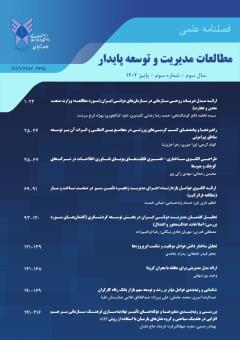ارائه مدل ضربات روحی سازمانی در سازمانهای دولتی ایران (مورد مطالعه: وزارت صنعت، معدن و تجارت)
محورهای موضوعی : مدیریت رفتار سازمانی
سیده فاطمه قانع کوشالشاهی
1
![]() ,
حمید رضا رضایی کلیدبری
2
*
,
حمید رضا رضایی کلیدبری
2
*
![]() ,
داود کیاکجوری
3
,
داود کیاکجوری
3
![]() ,
بهزاد فرخ سرشت
4
,
بهزاد فرخ سرشت
4
![]()
1 - دانشجوی دکتری، گروه مدیریت، دانشگاه آزاد اسلامی واحد چالوس، چالوس، ایران.
2 - استادیار، گروه مدیریت، دانشگاه آزاد اسلامی واحد رشت، رشت، ایران.
3 - دانشیار، گروه مدیریت، دانشگاه آزاد اسلامی واحد چالوس، چالوس، ایران.
4 - استادیار، گروه مدیریت، دانشگاه آزاد اسلامی واحد چالوس، چالوس، ایران.
کلید واژه: سازمانهای دولتی, ضربه روحی سازمانی, سازمانهای آسیبدیده,
چکیده مقاله :
یکی از پدیدههای مهمی که امروزه سازمانها را تهدید میکند، ضربههای روحی و روانی است که در سازمانها ایجاد شده و منجر به ایجاد پیامدهای مخربی میشود. هدف این پژوهش، ارائه مدل ضربات روحی در سازمانهای دولتی ایران است. پژوهش حاضر به لحاظ هدف، توسعهای - کاربردی و از نظر روش انجام کار، آمیخته از نوع اکتشافی است. جامعه آماری پژوهش در مرحله کیفی، شامل خبرگان دانشگاهی در حوزه مدیریت دولتی و جامعه آماری مرحله کمّی، تمامی کارکنان وزارت صنعت، معدن و تجارت بوده است. نمونه آماری در بخش کیفی با رویکرد هدفمند قضاوتی به تعداد 10 نفر و در بخش کمّی به روش نمونهگیری خوشهای به تعداد 338 نفر انتخاب شده است. ابزار جمعآوری دادهها در مرحله اول شامل مصاحبه نیمه ساختاریافته و دو مرحله دلفی و در مرحله دوم پرسشنامه 55 سؤالی است که روایی و پایایی پرسشنامه تأیید شده است. تجزیه و تحلیل دادههای کیفی با استفاده از روش داده بنیاد و نرم افزار MAXQDA و دادههای بخش کمّی به روش معادلات ساختاری در نرم افزار SMART-PLS 3انجام شده است. نتایج نشان داد که در بخش کیفی 27 مضمون سازمان دهنده و سه مضمون فراگیر از عوامل ایجاد کننده ضربات روحی در سازمانهای دولتی و 20 مضمون سازمان دهنده و 4 مضمون فراگیر از پیامدهای ضربات روحی و 8 شاخص مضمون سازمان دهنده و 2 مضمون فراگیر از ویژگیهای سازمانهای آسیب دیده شناسایی شده است. همچنین، در بخش کمّی مدل پژوهش بر اساس نتیجه تحلیل عاملی مرتبه دوم مورد تأیید قرار گرفته است.
One of the important phenomena that threatens organizations today is emotional and psychological traumas that are created in organizations and lead to destructive consequences. The purpose of this research is to provide a model of morale in Iran's government organizations. The current research is developmental-applicative in terms of its purpose, and in terms of the method of doing the work, it is mixed of the exploratory type. The statistical population of the research in the qualitative stage included university experts in the field of public administration and the statistical population of the quantitative stage included all the employees of the Ministry of Industry, Mines and Trade. The statistical sample was selected in the qualitative section with a targeted approach of 10 people and in the quantitative section, 338 people were selected by the cluster sampling method. The data collection tool in the first stage includes a semi-structured interview and two Delphi stages and in the second stage there is a 55-question questionnaire whose validity and reliability of the questionnaire has been confirmed. Qualitative data analysis was done using foundation data method and MAXQDA software, and quantitative part data was done using structural equation method in SMART-PLS 3 software. The results showed that in the qualitative part, there are 27 organizing themes and three comprehensive themes of the factors that cause morale in government organizations, 20 organizing themes and 4 inclusive themes of the consequences of morale attacks, and 8 indicators of the organizing theme and 2 inclusive themes of the characteristics of organizations. Damaged has been identified. Also, in the quantitative part, the research model has been confirmed based on the result of the second-order factor analysis.

